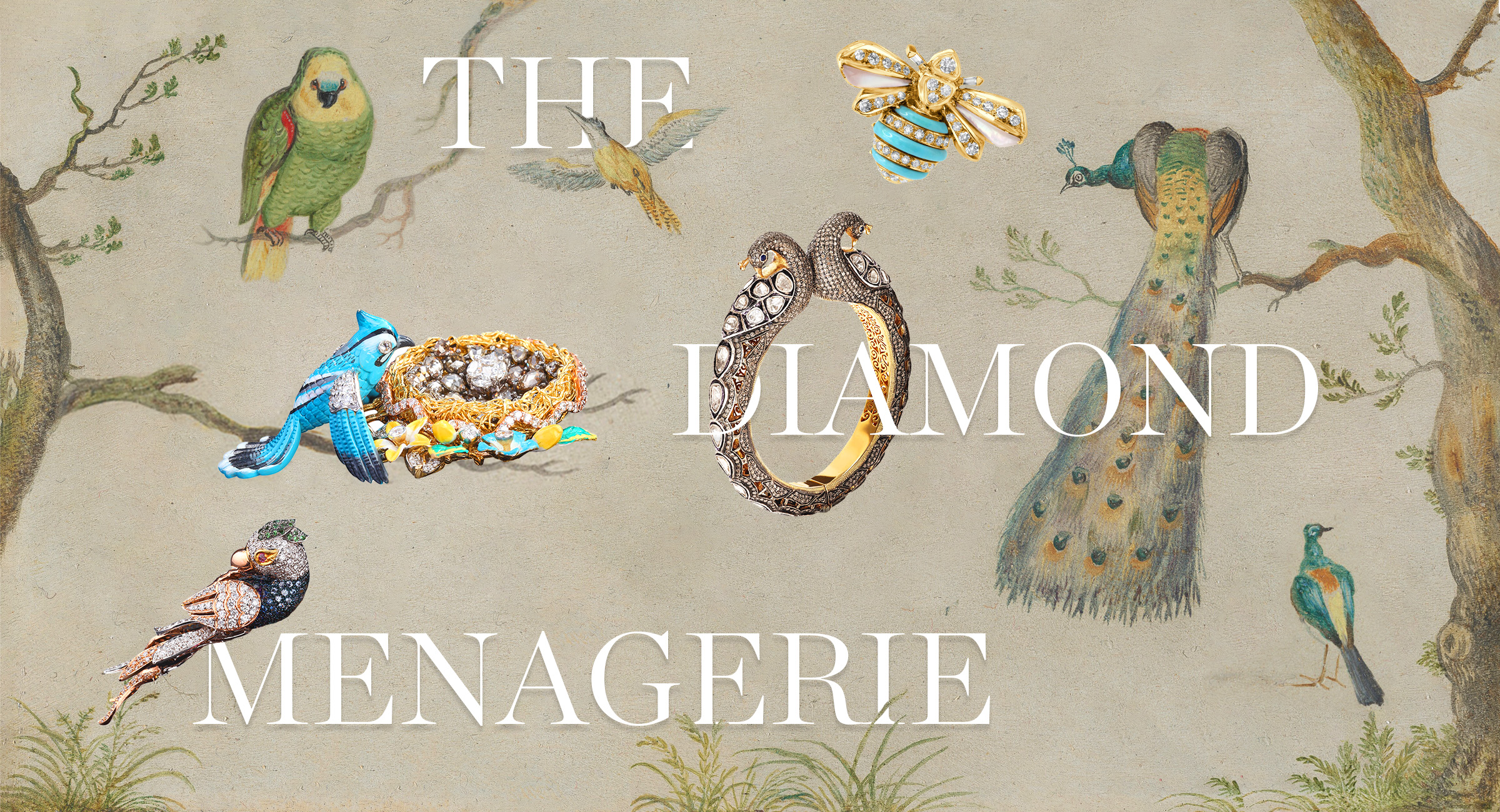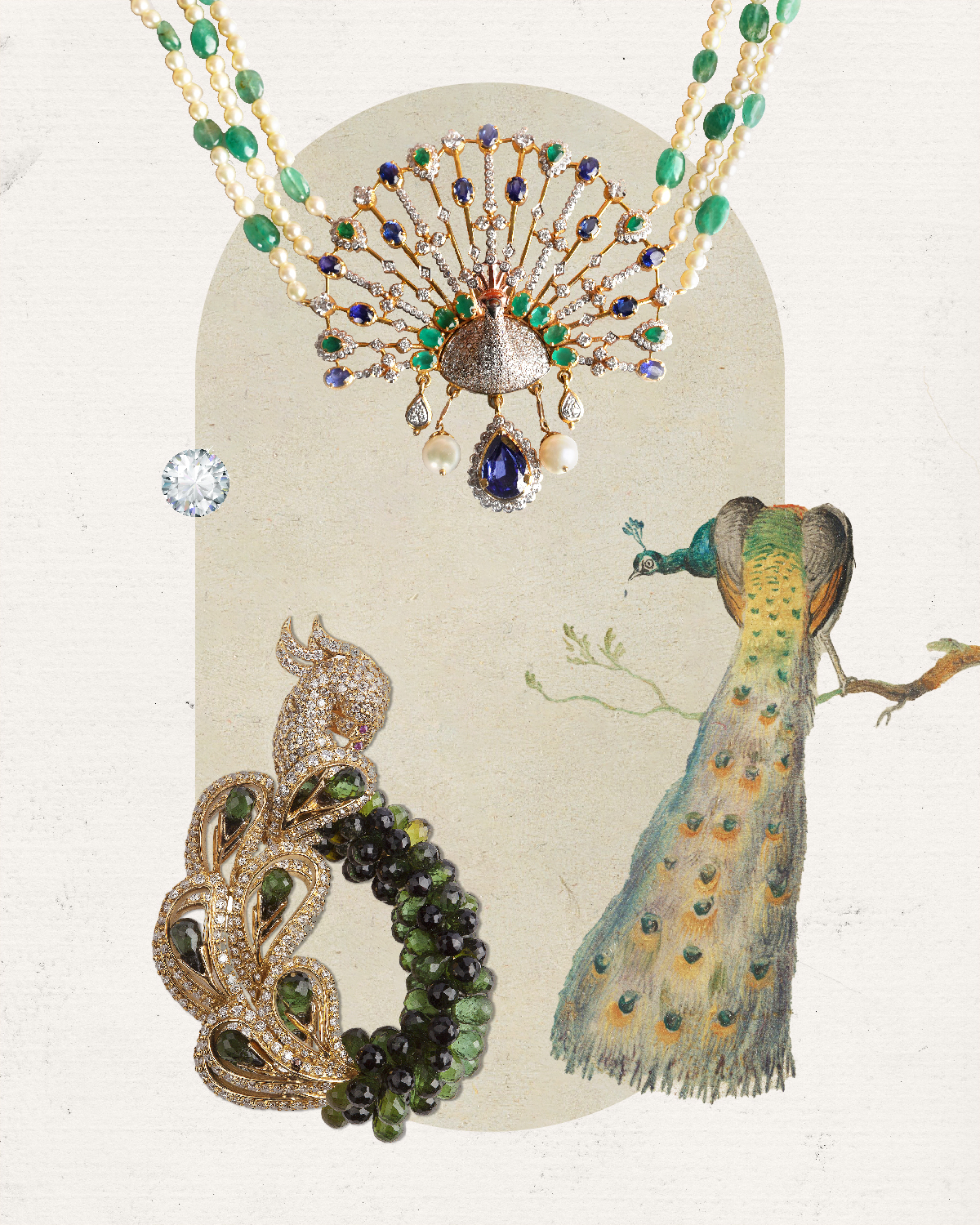A Safari into the Diamond Jungle
Jewellery with fauna motifs, embellished with natural diamonds, have transcended mere adornment to become iconic symbols of exquisite craftsmanship and timeless elegance.

Throughout history, artists have drawn inspiration from nature, using materials like ivory, shells, and feathers to create intricate designs. This primal creative desire transcends time, making beautification an integral part of human expression. Nature-inspired motifs and symbols of worship became recurring themes in ornaments. One of the earliest Indian examples is a pair of gold earrings belonging to the Satavahana dynasty from the 1st Century BCE, found in Andhra Pradesh. The earrings feature floral motifs, as well as a lion and an elephant, both of which are emblems of royalty.
Nature, a Glittering Muse

The artistic representation of zoomorphic and avian images in particular is deeply rooted in Buddhist and Hindu legends, inspired by India’s diverse landscape and its natural abundance. Animals like peacocks, turtles, bulls, horses, elephants, and lions serve as symbols in Buddhist lore. In Hindu mythology, creatures like fish, tortoises, boars, narasimha (half lion and half man), bulls, lions, tigers, parrots, mice, peacocks, geese, swans, eagles, and serpents play significant roles as vehicles or vahanas for various gods.
Birds, animals, and fantastical creatures served as defenders and guardians, while seeds and flowers symbolise fertility and beauty.
Puja Shah, co-founder of Aurus Jewels credits the Mughals for enriching the artistic expression of nature’s different forms during their reign in India. “The Mughal era marked an increased representation of flora and fauna motifs in art, not only because Muslims don’t use human forms in their art but also because they have historically been highly inspired by nature. When they came to India, the first three emperors (Babur, Humayun and Akbar) carried the legacy on from their homeland in Central Asia by bringing the craftsmen for architecture, textiles, and also jewellery to recreate those motifs and techniques.”
Beyond their aesthetic appeal, each creature bears symbolic significance, bestowing jewellery with an almost talismanic value when worn, conveying beauty, strength, courage, valour, and protection.
Zoomorphic Motifs and Their Symbolism

The peacock – symbolising immortality and beauty, and the blossoming of love – represents an incarnation of Lord Vishnu. In Tamil mythology, it serves as the vahana (vehicle) of Murugan, the God of war, victory, love, and wisdom, which explains its widespread usage in royal jewellery back in the day, with one of the most stunning examples being the last ruler of Kapurthala, Maharaja Jagjit Singh’s aigrette depicting an exquisite peacock fashioned out of rose-cut diamonds, blue, green, yellow and golden brown enamel and 18kt gold.
Particularly popular in women’s jewellery, serpents are associated with fertility in Hinduism, and have hence become a common jewellery motif across India. Perhaps its most prominent representation is in a jadanagam – a long, tapered ornament worn along the length of a single long braid or plait. Literally translating to ‘plaited serpent’, a jadanagam is often designed as an abstract representation of a hooded serpent. The jadanagam shown here is an antique piece made in rose-cut diamonds, rectangular and circular-cut rubies, pearls, silver and gold.

Lions and tigers, symbols of strength and sovereignty, have long adorned royal regalia. One of the most stunning examples is Maharaja Jagjit Singh’s state sword hilt which famously featured a ruby-eyed, real diamond encrusted tiger head with the words ‘Kapurthala State’ set in natural diamonds. Decades later, ace design house Sabyasachi would come to be globally recognised by its immaculately cloned Royal Bengal Tiger, emblematic of the designer’s roots in Kolkata, West Bengal. Yet another enigmatic representation of a beast with pre-historic roots, the croc, the Gem Palace’s ‘Crocodile Ring’ is moulded in 18kt gold and silver with round natural diamonds and Cabochon rubies.

The elephant, revered in Hindu iconography, is associated with prosperity and denotes strength, calmness, and gentleness, epitomised by Lord Ganesha and Airavat, the vahana of Indra. Renowned historian and art consultant Dr. Usha R. Bala Krishnan, and writer Meera Sushil Kumar note that animals like the elephant are “…quintessential elements of jewellery design particularly in South India….[They are] regarded as an epiphany of God” (Dance of the Peacock: Jewellery Traditions of India, p244). David Webb jewellery’s elephant brooch from 1965 features an Indian elephant in ceremonial dress, composed of carved rubies, fluted, cabochon and pear-shaped emeralds and pear-shaped rubies, accented by round and single-cut diamonds; the tusks are applied with white enamel.
In Hindu mythology, the parrot holds a connection to Kama, the God of love, and his consort Rati. Depicted riding a parrot with bow and arrow in hand, Kama’s parrot symbolises love and affection. Given their profound symbolism, parrots emerge as classic motifs in jewellery. Gem Palace’s rightfully named ‘Love Emerald’ necklace employs the parrot motif masterfully with a pair of natural diamond encrusted parrots perched on a huge emerald-shaped heart that forms the centre of the pendant.

Mythological beings from Hinduism also inspire Indian jewellery, such as the Gandaberunda, a two-headed eagle, and the Makara, a guardian amphibian, often seen in pendants and bangles. The Gandaberunda symbolises resilience against destructive forces and was the emblem of the Kingdom of Mysore under the Wodeyar kings, crafted by renowned jeweller C. Krishnaiah Chetty.
“In traditional jewellery, the Gandaberunda is meticulously crafted with detailing, capturing the essence of its mythological significance,” stated Dr. C. Vinod Hayagriv, managing director of C. Krishniah Chetty. “Cabochon rubies along with natural diamonds play a pivotal role in enhancing the allure of Gandaberunda jewellery. They are often incorporated into the design to symbolise purity, eternity, and luxury. Rubies, emeralds, pearls and diamonds have been used to accentuate the eyes, feathers, and other intricate parts of the bird, adding a sparkling dimension to the piece.”
“This integration of natural diamonds not only elevates the aesthetic appeal but also infuses a sense of opulence and timelessness into the design.”

He also added that apart from gems, intricate goldsmithing techniques such as their signature closed-back setting and embossing are often employed to bring out the fine details of the mythical bird. Coloured gemstones as well as certain techniques of enamel work, and other precious materials may also be used to add vibrancy and richness to the overall design.
The Craftsmanship Behind and Beyond Adornment
Crafting realistic animal jewellery is an intricate art, transforming metals and gemstones into anatomical marvels. It’s more than design—it requires studying and understanding the creatures to bring them to life with precision. Skilled craftsmen meticulously select and place gemstones, with goldsmithing playing a vital role in creating these detailed pieces.
These pieces go beyond mere adornment; they represent a fusion of artistic vision, technical mastery, and a profound appreciation for the beauty found in the animal kingdom.

When the motif is a stylised version as opposed to a realistic animal, as in Aurus’ Shaheen necklace, a lot goes in before the design can be brought to life. “The bird in the Shaheen necklace is an imaginary bird that looks like it’s ready to spread its wings and take flight. It is a mix of various different birds that I’ve observed in flight, drawn, made into a 3D model, and then encrusted with polki/uncut diamonds using the traditional jadai technique.”
Speaking of the gemstones typically used for fauna motifs, Aurus’ Shah noted, “Emeralds, rubies and sapphires are an obvious choice when it comes to crafting fauna motifs because green represents the vegetation, red the flower, and blue that supports these two; they’re also complemented by the diamonds perfectly. Like in our Leela necklace which features a stylised 2D peacock encrusted with natural diamonds and precious stones.” Both polki and brilliant cut diamonds contribute richness and brilliance, intensifying the hues of accompanying gemstones.
In the Modern Menagerie

The Gem Palace’s ‘Love Emerald’ pendant and Sabyasachi’s Royal Bengal Tiger motif in fine jewellery exemplify the evolution of bestial motifs in Indian jewellery. These pieces challenge traditional portrayals, offering modern and avant-garde interpretations.
Leading jewellery houses worldwide are also embracing animal-inspired designs more than ever, from marine creatures to big cats with a surreal twist. Signature animals, like Cartier’s panther, Chanel’s lion or Bulgari’s serpent, add iconic touches. Chopard’s exquisite Rat Necklace, crafted in 18kt white gold and set with 10 heart-shaped rubellites, diamonds, and pink and grey diamonds give the rodent an unexpectedly luxurious facelift. Or, take La Marquise’s playful innovation with bees, in earrings and pendants crafted in 18kt rose gold, real diamonds, Tapper Baguette, turquoise and pink Mother of Pearl that will keep people abuzz with surprise.
Clearly, it’s time for you to step into the jungle, too.
